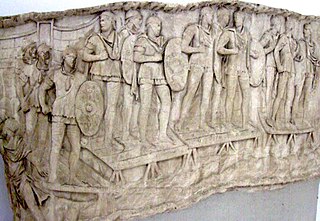
The Roman legion, the largest military unit of the Roman army, comprised 4,200 infantry and 300 equites (cavalry) in the period of the Roman Republic and 5,600 infantry and 200 auxilia in the period of the Roman Empire.

Military ranks are a system of hierarchical relationships, within armed forces, police, intelligence agencies or other institutions organized along military lines. The military rank system defines dominance, authority, and responsibility in a military hierarchy. It incorporates the principles of exercising power and authority into the military chain of command—the succession of commanders superior to subordinates through which command is exercised. The military chain of command constructs an important component for organized collective action.

The Praetorian Guard was an elite unit of the Imperial Roman army that served as personal bodyguards and intelligence agents for the Roman emperors.
A cohort was a standard tactical military unit of a Roman legion. Although the standard size changed with time and situation, it was generally composed of 480 soldiers. A cohort is considered to be the equivalent of a modern military battalion. The cohort replaced the maniple. From the late second century BC and until the middle of the third century AD, ten cohorts made up a legion. Cohorts were named "first cohort", "second cohort", etc. The first cohort consisted of experienced legionaries, while the legionaries in the tenth cohort were less experienced.
The equites constituted the second of the property-based classes of ancient Rome, ranking below the senatorial class. A member of the equestrian order was known as an eques.

The Roman army was the armed forces deployed by the Romans throughout the duration of Ancient Rome, from the Roman Kingdom to the Roman Republic and the Roman Empire, and its medieval continuation, the Eastern Roman Empire. It is thus a term that may span approximately 2,205 years, during which the Roman armed forces underwent numerous permutations in size, composition, organisation, equipment and tactics, while conserving a core of lasting traditions.

In the Roman army during classical antiquity, a centurion, was a commander, nominally of a century, a military unit originally consisting of 100 legionaries. The size of the century changed over time, and from the first century BC through most of the imperial era was reduced to 80 men.

Vicarius is a Latin word, meaning substitute or deputy. It is the root of the English word "vicar".
Comes was a Roman title or office, and the origin Latin form of the medieval and modern title "count".

Officium is a Latin word with various meanings in ancient Rome, including "service", "(sense of) duty", "courtesy", "ceremony" and the like. It commonly also referred to the office of a magistrate and his sometimes numerous staff, each of whom was called an officialis.
A vexillatio was a detachment of a Roman legion formed as a temporary task force created by the Roman army of the Principate. It was named from the standard carried by legionary detachments, the vexillum, which bore the emblem and name of the parent legion.

The auxilia were introduced as non-citizen troops attached to the citizen legions by Augustus after his reorganisation of the Imperial Roman army from 27 BC. By the 2nd century, the Auxilia contained the same number of infantry as the legions and, in addition, provided almost all of the Roman army's cavalry and more specialised troops. The auxilia thus represented three-fifths of Rome's regular land forces at that time. Like their legionary counterparts, auxiliary recruits were mostly volunteers, not conscripts.

In modern scholarship, the "late" period of the Roman army begins with the accession of the Emperor Diocletian in AD 284, and ends in 480 with the death of Julius Nepos, being roughly coterminous with the Dominate. During the period 395–476, the army of the Roman Empire's western half progressively disintegrated, while its counterpart in the East, known as the East Roman army remained largely intact in size and structure until the reign of Justinian I.
A turma, was a cavalry unit in the Roman army of the Republic and Empire. In the Byzantine Empire, it became applied to the larger, regiment-sized military-administrative divisions of a thema. The word is often translated as "squadron" but so is the term ala, a unit that was made up of several turmae.

A legatus Augusti pro praetore was the official title of the governor or general of some Imperial provinces of the Roman Empire during the Principate era, normally the larger ones or those where legions were based. Provinces were denoted imperial if their governor was selected by the emperor, in contrast to senatorial provinces, whose governors were elected by the Roman Senate.

The Imperial Roman army was the military land force of the Roman Empire from 27 BC to 476 AD, and the final incarnation in the long history of the Roman army. This period is sometimes split into the Principate and the Dominate (284–476) periods.
Traianus Mucianus was a Roman soldier of Thracian origins of the second half of the Third Century AD who rose from the lowest ranks of the army to senior commands. He was almost certainly a remarkable soldier. However, the successive promotions he secured in the latter part of his career are thought to owe much also to the favour shown him by men highly placed in the Imperial entourage whose patronage secured him advantageous postings in the Imperial comitatus, the mobile field force under the direct command of the Emperor, that was undergoing massive expansion at this time.
Cohors prima Ulpia Dacorum was an infantry regiment of the Auxilia corps of the Imperial Roman army. It was founded by the Roman emperor Trajan, probably in preparation for his planned war against Parthia (113-6). The regiment's honorific title Ulpia refers to the emperor's gens, or clan-name.